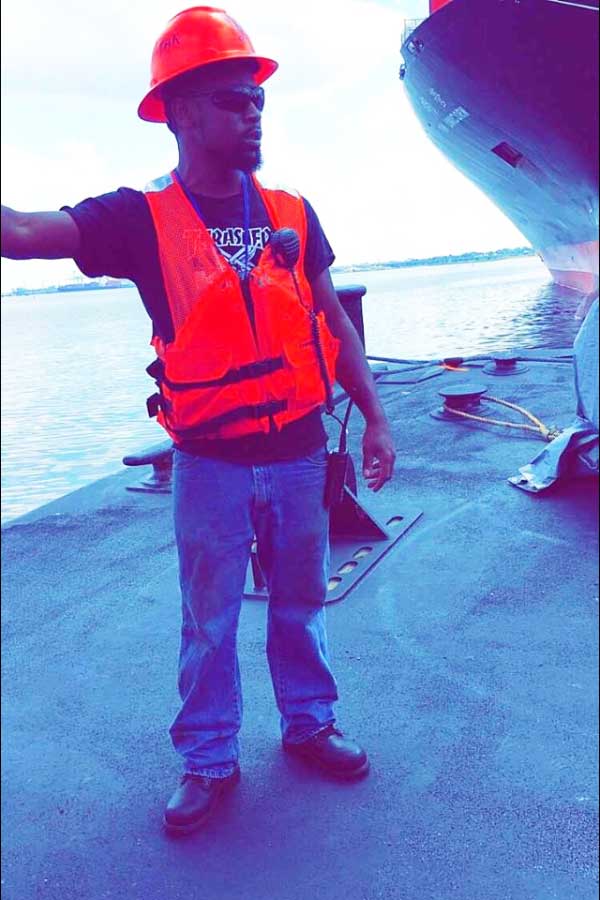Engineering Department
What type of work would I do every day?
The progression of ratings for Engineering Officers on a ship is shown below:

The progression does not need to be linear; individuals can move between different levels based on education and experience.

Breshon Cuffee working with Norfolk Tug Company during his internship. Breshon is currently employed by Norfolk Tug company. (August 2016)
General Steam and Motor Vessels
A ship’s engineering department consists of the members of a ship’s crew that operate and maintain the propulsion and other systems on board the vessel. Marine engineering staff also deal with the sewage, lighting, air conditioning and water systems. They deal with bulk fuel transfers, and require training in firefighting and first aid, as well as, in dealing with the ship’s boats and other nautical tasks – especially with cargo loading/discharging gear and safety systems.
Members of any department are broken into categories of “licensed” and “unlicensed”. Licensed members of the deck are usually officers with significant responsibilities that include an “engineering watch”. A common engineer crew for a ship includes the following roles (in order of most experience):
1. Wiper. A wiper is the most junior crewmember in the engine room of a ship. Their role consists of cleaning the engine spaces and machinery, and assisting the engineers as directed.
2. Qualified Member of the Engine Department. Also known as an Unlicensed Junior Engineer or QMED, is a senior unlicensed crewmember in the engine room of a ship. There are different ratings of QMED, each with different roles, including, Fireman, Oiler, Deck Engineer, Junior Engineer, Refrigeration Engineer, Electrician, and Pumpman. In general, the QMED performs a variety of tasks connected with the maintenance and repair of engine room, fire room, machine shop, ice machine room, and steering engine room equipment. The QMED inspects equipment such as pumps, turbines, distilling plants and condensers, and prepares record of condition. The QMED lubricates and maintains machinery and equipment such as generators, steering systems, lifeboats, and sewage disposal systems, and also cleans and restores tools and equipment.
3. Designated Duty Engineer. A qualified engineer who may be the sole engineer on vessels with a periodically unattended engine room. DDEs are typically on smaller vessels of 500 GRT or less. This is the basic licensed engineer class similar to the generic “Mate” rating in the Deck Department.
4. Third Assistant Engineer. The Third Assistant Engineer is junior to the Second Assistant Engineer in the engine department and usually stands a watch. The most junior marine engineer of the ship, he/she is usually responsible for electrical, sewage treatment, lube oil, bilge, and oily water separation systems. Moreover, the Third Assistant Engineer may assist the 3rd Deck Mate in maintaining proper operation of the lifeboats.
5. Second Assistant Engineer. The Second Assistant Engineer is junior to the Second Engineer/First Assistant Engineer in the engine department and is usually in charge of boilers, fuel, auxiliary engines, and condensate and feed systems. The engineer is the third highest marine engineer in rank. The Second Assistant Engineer is also typically in charge of fueling or bunkering, if the officer holds a valid Person in Charge (PIC) endorsement for fuel transfer operations.
6. First Assistant Engineer. The First Assistant Engineer is the officer responsible for supervising the daily maintenance and operation of the engine department. He/she reports directly to the Chief Engineer. The person holding this position is typically the busiest engineer aboard the ship, due to the supervisory role this engineer plays and the operation’s duties performed. Operational duties include responsibility for the refrigeration systems, main engines, and any other equipment not assigned to the Second Assistant Engineer or the Third Assistant Engineer.
7. Chief Engineer. A licensed member of the engine department who is qualified to oversee the entire department. The Chief Engineer is responsible for all operations and maintenance that have to do with engineering equipment throughout the ship. The Chief Engineer also determines the fuel, lube oil, and other consumables required for a voyage, required inventory for spare parts, oversees fuel, lube, and slop oil transfers, prepares the engine room for inspection by local marine/safety authorities (e.g. U.S. Coast Guard), oversees all major maintenance, is required to be in the engine room during maneuvering operations, and is in charge of the engine room during emergency situations.
Apply Now
Apply Now For The TRLMI Boot Camp
